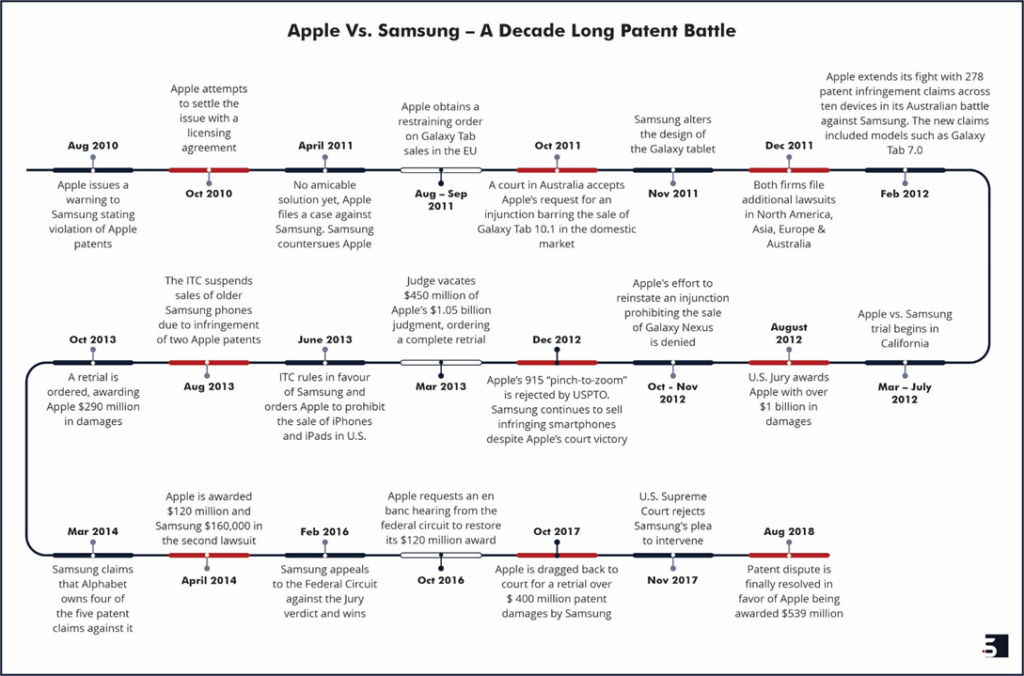All About Design Patents & Its Impact on Industries
Smartphones have become ubiquitous in our daily lives in such a demanding way that it is unfathomable to imagine even a day without it (for most of us). It defined our generation, bringing technology from computers to our hands. This change in lifestyle saw the advent of the Great Patent War between technological giants fighting a fierce battle for dominance. The battle for market supremacy has been fought as much in the marketplace as in the courts, in a clash that has seen technology businesses such as Apple get embroiled in some of the most publicized lawsuits— starting with Nokia vs. Apple in a series of cases in 2009 and 2010. Later on, the first Apple vs. Samsung trial, which took place in 2012, enthralled Silicon Valley and the I.T. industry as it revealed the inner workings of the two private businesses.
The main point of contention between Apple and Samsung was their patents, which covered components of their products via design patents. The dispute highlighted the importance of protecting design through patents in order to save millions of dollars in lost revenue and brand uniqueness.
In this article, we will discuss the various design patent wars fought over the years and how they have shaped various industries.
Table of Contents
Design Patents and their Significance
Design patents are issued on the decorative or ornamental design of an item. There are numerous industries where design patent protection is an effective strategy to safeguard your intellectual property. The design of a product is usually what people want to protect because it is something that is visual – it is what draws a person to a product.
Design patents can restrict your competitors from using your designs. In addition, they can fetch hefty settlement payments for the owner of the design and successfully prohibit further knock-offs. Design patents are awarded far more swiftly than utility patents — often in around 9 to 18 months, as opposed to an average of 2.5 to 3 years for utility patents in various industry sectors. And they are granted for a period of 14 years without any additional maintenance fees.
In infringement litigation, design patents can be extremely beneficial. When a competitor duplicates a product directly, it is relatively simple for a jury to compare the photos and determine infringement. It does not necessitate a thorough understanding of technological difficulties. On the other hand, utility patents frequently entail complex technology that can be difficult for a jury to appreciate. It is, therefore, imperative that one’s portfolio consists of design patents that can be extremely beneficial in the future.
Now that we understand the design patents and their importance, let us discuss design patent searches and why they are crucial to secure a patent grant.
Design Patent Searches and their importance
A design patent search is all about analyzing existing patents to ensure that a similar or identical design has been previously patented. A design patent is granted if the design is unique, novel, or authentic. It is valid for 14 years from the date of filing. Additionally, it enables an innovator to develop a novel method of designing an existing product. The design patent protects one-of-a-kind design without invalidating an existing patent.
Although design patents are filed for nearly every industry, they are more commonly applied across domains such as furniture, hardware, tools, food preparation, sporting items, toys and games, and communication equipment.
A design patent is often confusing for inventors who are unsure if they require this or a utility patent. The primary distinction between the two is that a utility patent protects the complete product, whereas a design patent protects simply the design. An example is a fresh embossed design on a tissue. Although the tissue is unlikely to be patented due to its long history, however a designer may construct a unique embossed design in the tissue and qualify for a design patent.
A design patent search is critical since it will keep you from replicating an existing patent. Numerous websites allow you to do a search for existing design patents. However, exercise caution when conducting your own search. Certain websites have limitations and will not list all existing design patents.
You can do a search at the United States Patent and Trademark Office (USPTO) library that is closest to you. If you do not have access to a physical library, you can also search for patents using Google Patent Search or the USPTO website, etc. Paid search services for design patents, such as Simple Patents and Quick Patents, may yield more results. The cost of using one of these search tools ranges from $175 to $300 (approx.), depending on the intricacy and services offered.
With a sound understanding of design patent searches and their importance, it is crucial to be aware of the history of design patents.
Brief History of Design Patents
Most people think of utility patents when they think of patents, which are granted for an equipment, a process, a product, or a composition of matter. A utility patent includes a thorough technical description, illustrations (if applicable), and one or more claims. A utility patent’s claims outline the components of the invention and define the scope of the patent. In contrast, the design patent relies heavily on the drawings to describe what is protected. A design patent has only one claim. Rather than naming any structures or explaining the design in words, this claim simply refers to the drawings as a standard for what is protected. While utility patents are granted for new, useful, and unobvious ideas, a design patent is granted for an ornamental design of a commercial item. The design of an object is defined by the United States Patent and Trademark Office as the visual qualities or elements shown by the object.
A design patent is an exclusive legal protection for an item’s distinct visual attributes. It protects the decorative aspect of something that has some utilitarian purpose. While a design patent may be granted for an utilitarian item, such a patent can only be obtained if the decorative features outnumber the practical features. In the United States, a design patent is not available to protect a design that is primarily utilitarian in character.
Despite the fact that the first Patent Act was passed in 1790, it took another 52 years for the US patent laws to be changed to allow for the patenting of ornamental designs. Patents were granted for any novel and original design for a manufacture; design for printing on fabrics; bust or statue; imprint to be placed on an article of manufacture; or shape or configuration of any article of manufacture in 1842. The design patent statute was then updated in 1902 to merely describe acceptable subject matter as “any new, unique, and ornamental design for an article of production.”
While the first design patent was issued to George Bruce in the United States on November 9, 1842, it is quite surprising to note that it did not include any drawings whatsoever. This is quite strange in today’s norm since the design process heavily relies on illustrations to cover every aspect of the design in detail. Mr. Bruce’s design patent was explained in words rather than claiming the ornamental design, as you would today.
In 2008, the U.S. Federal Circuit altered the design patent infringement test to one of substantial resemblance, making it easier to prove design patent infringement.
Earlier Patent Wars in History
Patent battles are not a new occurrence. They have probably been a part and parcel ever since the invention of an airplane. The Wright brothers, accredited with inventing the airplane, used lawsuits to prohibit competitors from producing airplanes, impeding the growth of the American airline industry. Alexander Graham Bell, the inventor of telephone, was drawn into a patent dispute with his competitors that lasted 11 years and resulted in 600 lawsuits. A well-known example is Bell’s lawsuit against Western Union. Initially, Western Union had expressed little interest in Bell’s patent when he desired to sell it. The company was more interested in Elisha Gray Patent, another established inventor in the telegraphy field. Eventually the lawsuit was settled in favor of Graham Bell’s company.
The digital age has shaped the occurrence of patent battles. In the 1980s, technology firms in the United States and Japan waged a patent war, forcing businesses to “fight patent with patent.” By the mid-1990s, this bilateral patent battle had faded, albeit somewhat dramatized by the media. The emergence of patent trolling exacerbated the frequency of patent warfare. This phrase “patent troll”, was coined in the 1990s by Intel employees and popularized by Peter Detkin, an Intel executive. Throughout the 1990s, federal courts began reversing earlier patent office judgments. In late nineties, antivirus software companies Trend Micro, Integralis, McAffee, and Symantec were engaged in a patent war. Two years later, there was a tussle between Amazon and Barnes & Noble over patenting “one-click ordering technology.” Adding to the list were Sony and Kodak, who began a patent war in 2004 over digital cameras, which lasted until 2007.
Over the last 15 years, patent litigation trends have been dynamic, frequently responsive to legislative, administrative, and judicial developments.
From 2005 until a high in 2011-2012, total patent litigation more than doubled, but has since decreased. The majority of the long-term tendency is due to NPE activities.
Timeline of Apple Samsung Patent Wars
The tale of Apple-Samsung patent war has become a part of boardroom discussion. But do you know that the origin of the story dates back to January 4, 2007, four days before the stellar iPhone was introduced to the world? Apple had filed a suite of four design patents related to the basic shape of the iPhone. Subsequently, in June of the same year, a massive number of color design patents covering 193 screenshots of various iPhone’s graphical user interfaces were also filed. (Source)
The four design patents that were initially filed are discussed below:
- D558757: This design patent covered the basic shape of the iPhone, i.e., a flat box with rounded edges. Eight different views (shown in Figure 1 below) of the article were covered in the design patent including front perspective view, rear perspective view, front view, rear view, top view, bottom view, left view, and the right view.

- D558756: The design patent included other parts and features of the article, such as connectors, screens, buttons, etc. Eight different views (shown in Figure 2) of the article were covered in the design patent including, front and rear perspective view, front view, rear view, top view, bottom view, left view, and the right view.

- D580387: This design patent covered the article’s surface finish (glass-like). Eight different views (shown in Figure 3) of the article were covered in the design patent including, front and rear perspective view, front view, rear view, top view, bottom view, left view, and the right view.

- D558758: The design patent covered the article’s color aspect, i.e. black, silver, etc. Eight different views (shown in Figure 4) of the article were covered in the design patent including, front and rear perspective view, front view, rear view, top view, bottom view, left view, and the right view.

The legal dispute between Apple and Samsung began when Samsung started distributing Android handsets. This led to Steve Jobs, the then CEO of Apple to famously refer to it as a “stolen” product – aka a knockoff of the iPhone. Here’s how the tussle between the two unfolded:

So who won the battle?
Both Apple and Samsung were found guilty of infringing on each other’s patents during the patent trial. While Samsung was not required to pay the initial $1 billion in damages, it did suffer a humiliating setback. And Apple, which was also found guilty of duplicating several of Samsung’s patents, was adamant that the penalty was excessive. The case highlights the significance of protecting and enforcing your design patents to save millions of dollars in lost revenue and brand dilution.
Impact of Smartphone Patent Wars on Electronics & Communication Industry
The outcome of smartphone patent war placed the onus on electronics and communication industry to rethink their strategy of designing a product. The litigation cost and the punitive action of court to award whooping amount to plaintiff accelerated a change in design strategy. Unlike previous years, where an existing design could be tweaked and launched in the market was no longer feasible. Consequently, the design patent registration count has been on the rise after the year 2011, as shown in the below-mentioned charts.
How Patent Wars Impacted Annual Patent Trends

As seen from Figure 6 above, the count of design registration increased from 9023 in 2011 to 19530 by 2019, (more than 100% growth) in the backdrop of the smartphone patent war. Two of the design patent in litigation, D504889, D618677, falls under the 14-02 Locarno Classification. The upward trend has been for this classification only, indicating that a lot of development and innovation has taken place in the data processing devices.

Figure 7 clearly shows the rising upward trends from the year 2011 (12315) to 2019 (24595) – a growth of almost 100%. One of the design patents in litigation, D593087 falls under the 14-03 Locarno Classification. The upward trend has been for this classification only, indicating that a lot of development and innovation has taken place in telecommunications devices.

From Figure 8, we can see that design patent registration count indicates an upward trend from 2011 to 2016 and then a downward trend, giving up what it has gained in the growth period by 2020.
Now that we have discussed the design patent trade under Locarno classification, let us move to US- based design classification patent trends.

From Figure 9, it is evident that the count of design patent records (US Class D14/341, for design patent number, D504889) showed an upward trend from the year 2002 to 2013, with record count increasing from twenty-seven to two hundred and four. However, from the year 2013 onwards, the count has been on a constant decline with the figure reaching a low of eleven records in 2020.

From Figure 10, it is evident that the count of design patent records (US Class D14/138G, for design patent number, D593087) showed an upward trend from the year 2006 to 2010 with record count increasing from three to sixty-seven. After a dip in the year 2011, the count again increased and reached a maximum of 127 in 2013. However, since the year 2013, the count of design patent records has been sliding down consistently.

From the Figure 11, we can observe that the count of design patent record (US Class D14/203.7, for design patent number, D593087) showed an upward trend from the year 2002 to 2005 with record count increasing from three to thirty-five. After a dip in the year 2006, the count again increased and reached a maximum of 58 in 2009. Since then, there has been inconsistency in the count of design patent records.

From Figure 12, we can see that the count of design patent records (U.S. Class D14/248, for design patent number, D618677) showed an upward trend from the year 2010 to 2012 with record count increasing from twenty-three to one forty-six. The count increased again from 2017 to 2019, increasing from eighty-two to one hundred and thirty-four.
Having understood the design patent trends (Locarno and US class), let us discuss the role design searches in core business strategy.
Why Design Searches Should Be At The Core Of Your Business Strategy?
Industrial design contributes to a product’s commercial worth and marketability by making it more attractive and appealing to consumers. Protecting an industrial design enables a reasonable return on investment in the design’s creation.
Industrial designs enhance the aesthetics and attractiveness of a product. Consumer choice is influenced by design as the appearance of a product can be a significant element in a consumer’s purchase decision. This purchase decision can be determined, at least in part, by its appearance. Industrial design can thus be critical for both small and medium-sized businesses (SMEs) and larger corporations, independent of their industry.
Industrial design is critical for developing products that meet user demands and aspirations, while also standing out from the competitors. However, the majority of businesses do not realize the full benefits of design. This is frequently due to lack of technical knowledge, as well as hurdles to the integration of industrial design into the development process of new products. Those who do, reap the full benefits by including design search into their management strategy. To know more about design patents service, click here.
- Nitin Sharma, Mani Singhal (Engineering Searching) and the Editorial Team




